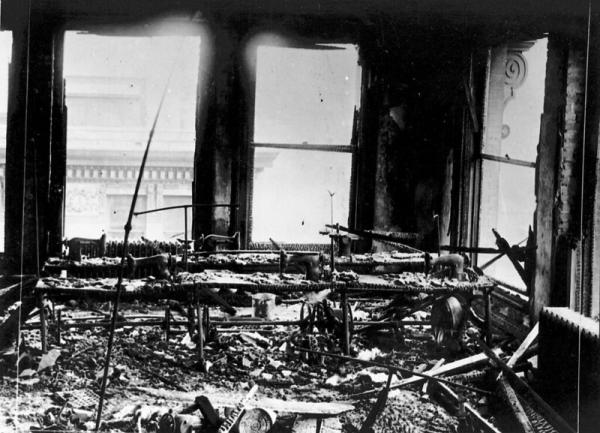There once was a time when Republicans protected the Progressives, and the Democrats guarded the moneyed class. That changed, in fits and starts, about 125 years ago. During that interim when few were focusing on worker health or safety, the worst workplace disaster in New York, until 9/11, transpired.
Tammany Hall, home of New York’s Democratic Party, was the bastion of the power elite – initially championing the haves. And then in a raw clutch for personal power they switched allegiances, currying favor with the burgeoning immigrant worker class who could now deliver the most votes. Policy, passion, and ideals were not in the mix; this was purely about control – of money, jobs, kickbacks, and patronages.
Those were the days when the Paris fashion industry dominated more than fashion – including insurance practices, employment, and even vocabulary. “Waists” referred to "Shirtwaists," the button-down blouses resembling men’s wear, the new fashion at the turn of the century, reflecting burgeoning roles for women and a more relaxed mode of dress.
Those trends intersected the day fire broke out on the 8th floor of the Asch Building in Greenwich Village, NY, quickly decimating the 8th, 9th, and 10th floors. Ironically, the fire broke out one day after the Worker’s Compensation Law of 1910 (proposed by progressive Republican Governor Charles Evans Hughes) was struck down by New York’s Highest Court as unconstitutional.
Investigation revealed a host of building inadequacies and unenforced regulations that contributed to the loss of life. This would have been a prime opportunity to mandate modern fire safety techniques and insurance reform.
Instead, District Attorney Charles Seymour Whitman, “a keenly political man” with sights on the White House, focused his efforts on a juicy story - the liability of the factory’s owners, Isaac Harris and Max Blanck, figuring that the publicity would be personally productive.
Harris and Blanck: The Shirtwaist Kings
To be sure, Blanck and Harris deserved to be indicted. Nevertheless, DA Whitman’s strategy, focusing on conviction on seven counts of manslaughter, was risky. And indeed, the pair were acquitted on all charges, largely due to the efforts of a legendary trial attorney, Max Steuer.
Whitman’s case against Blanck and Harris turned on whether the door to the ninth-floor stairway was locked at the time of the fire, preventing escape. Section 80 of the Labor Law was clear: at no time were stairway doors to be locked. Testimony on the matter was somewhat equivocal, but evidence mostly supported the locked-door theory, including the mountain of charred bodies found alongside it. The intrepid DA’s office even managed to locate the lock buried in the rubble and, with forensic experts of the day, introduced evidence that the bar was in the locked position.
The defense, of course, produced counter-testimony; but the jury was convinced that the door was locked. The problem was the Judge had instructed the jury that the owners had to know the door was locked at the time. On this, the jury holdouts believed there was not enough evidence to reach this conclusion beyond a reasonable doubt. Even testimony that the long-held practice of the owners, to keep only one door open at closing time so workers could be inspected for theft (albeit petty, evidence showed was a major concern of the owners), failed to sway the jury.
Surely, deaths would have been avoided if the door had been open. But obviating other safety infractions – the onus of which lay with the building department – clearly would have mitigated human loss, but went unaddressed for months as politically unattractive.
Here are a few:
- The no-smoking policy went unenforced. (An unextinguished cigarette butt or match on the 8th floor was said to be the initiating culprit).
- “Housekeeping” measures were not implemented. An estimated ton of highly flammable cotton scrap was sequestered under the cutters' tables, left for months without disposal, furnishing the perfect breeding ground for sparks.
- Instead of the required third stairway, the building owner was permitted to build a ramshackle fire escape (terminating in a blind alley over a basement skylight). There was no way to even get from the bottom of the fire escape to the street.
- The building doors swung inward - because the stairway landings were too narrow to accommodate outward-swinging doors. “The workers were jammed so tightly against [it]… and thronged so thickly against it, that the door couldn’t possibly open,” even if it weren’t locked.
- There were no direct communications to the 9th floor. The 8th-floor telephone connected to the 10th floor- and had to be rerouted to the 9th by the operator. By the time the alarm reached the 10th floor, the operator had disappeared.
- The buildings were too tall for fire department access, which at the time was only six stories. Any structure over that height was, in essence, a death trap.
After the fire, fire safety laws were enacted, primarily due to the leadership of Frances Perkins (later Secretary of Labor), and nearly every deficiency of the Asch building was addressed. Not so coincidentally by 1913, all-powerful Tammany Hall, under the new leadership of Robert Wagner and Alfred Smith, had shifted allegiances and were now on the side of the beleaguered worker.
It could have and should have come sooner but/for collusion with the Insurers
As early as 1835, Zachariah Allen, a Rhode Island cotton mill owner, revolted over the collusion between insurance companies and factory owners, which facilitated the maintenance of unsafe conditions: it was cheaper to pay even exorbitant premiums than to implement safety measures. Due to Allen’s efforts, including shared risk among factory owners, new practices were implemented:
“[T]he standard New England cotton mill was equipped with automatic sprinklers, firewalls, and fireproof doors (to restrict fires to one section of the factory and create safe zones for employees to run to) [and] death by fire was no longer a serious risk of mill life…. In Philadelphia, by 1911, enclosed fireproof stairways were taking the place of exposed iron fire escapes in commercial buildings.” [1]
So, why wasn’t this the practice in New York?
“The right fire at the right time was good for business.”
Shirtwaist manufacture was extremely lucrative, but turned on the whims of the Paris fashion police. One year “plain” was in vogue; the next year, it was “fancy.” That meant loads of unused merchandise – which cut into the bottom line.
New York City’s 11,000 textile factory owners thus had priorities other than safety: addressing their unsold inventory and recouping their losses. A 1913 article in Collier’s magazine by Arthur McFarlane profiled the “large and prosperous commercial arson industry. He reported, for example, that in 1910 Paris decreed that women’s dresses should be plain. “Soon there were weekly fires in New York’s braid and embroidery factories.” (1) These losses were covered or over-covered by insurance: higher premiums were still cheaper than safer buildings. And safer buildings also meant lower rates and commissions for politically connected insurance brokers, who made money not by reducing risk but by selling more and larger policies.
Blanck and Harris seem to have been prime beneficiaries of the scheme. With a history of fires in their factories, they prepared for blazes “not with safety measures… but buy buying ever-larger fire insurance policies.” They carried about 200 thousand dollars in coverage, recouping much more in property damage claims than paid out for worker deaths. With such motivation, installing sprinkler systems would have been counterproductive, and requiring fire drills an admission of a guilty conscience.
After the fire, “the two men ultimately collected a large chunk of insurance money - $60,000 more than the fire had cost them in damages. Harris and Blanck had made a profit from the fire of $400.00 per victim.”
Eventually, they reached a settlement with the victims’ families, agreeing to pay a weeks’ worth of wages for each worker. But the stories of impoverished families who had depended on the meager earnings of the Triangle workers, with little or no compensation, slowly got out.
Suddenly Workers Comp Becomes Constitutional
In 1914, a new Worker’s Compensation Law went into effect in New York. (Worker’s Compensation removes requiring employer negligence in exchange for a lower, but still realistic, scheduled payout). That law, too, was contested on the same grounds the earlier one was stricken: that it violated due process and upended common law, rendering it unconstitutional under the 14th Amendment. It wasn’t until three years later that the matter reached the US Supreme Court. And in 1917, Worker’s Compensation Laws were finally held constitutional. [2]
It seems it always takes a tragedy to enact laws that save lives - and politics constantly insinuates itself in the mix.
[1] Triangle – The Fire That Changed America David von Drehle
[2] Matter of New York Central Railroad C. v White, 243 U.S. 188 (1917) and Matter of Southern Pacific Co. v Jensen, 244 U.S. 205 (1917) overturning Matter of Ives v South Buffalo Railway, 201 NY 271 (1911)




